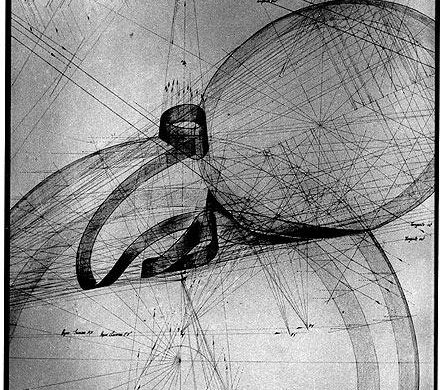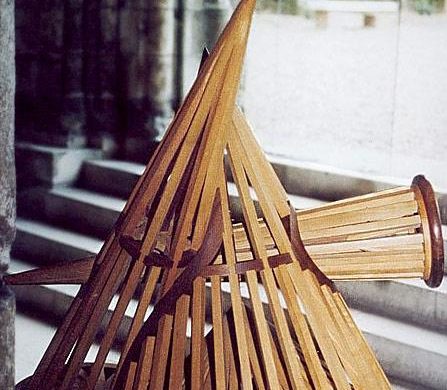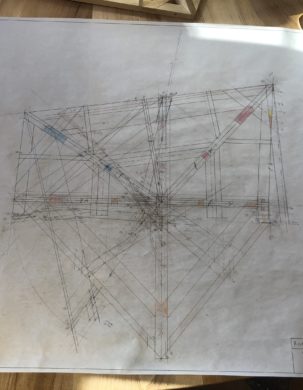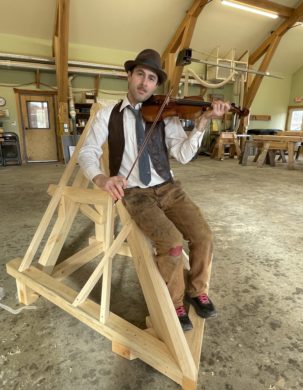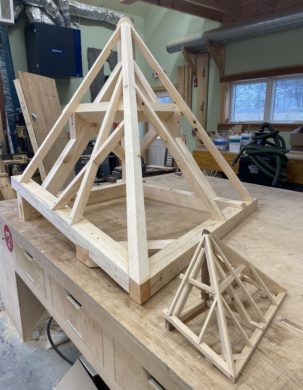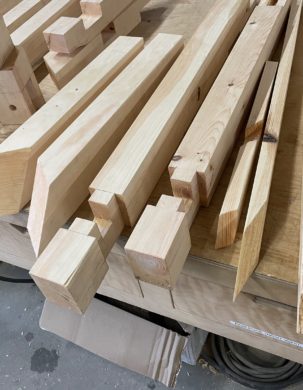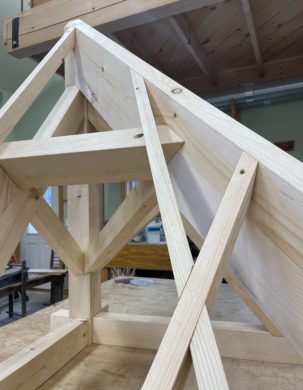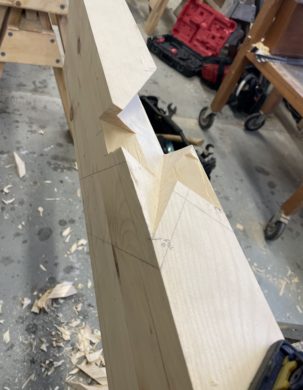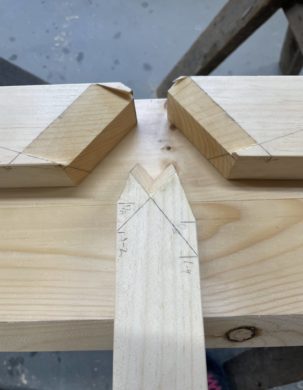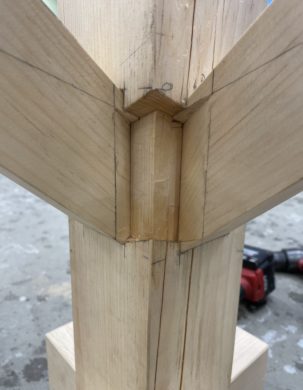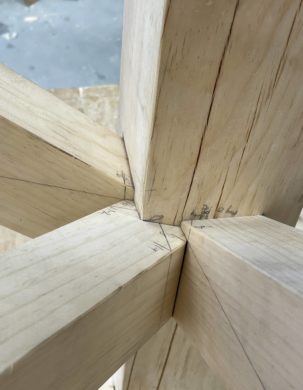This blog post was written by Ariel Schecter, who has moved on from TimberHomes to start his own business, Woodpecker LLC. You can learn more about stereotomy on his website here: https://www.woodpecker-llc.com/stereotomy
Howdy THVT blog followers! Ariel here to tell you a bit about a cool personal study project I do in my spare time. For the past number of years I’ve been studying a very old, very powerful carpentry drawing technique that hails from France called “le Trait.” Le Trait is an intricate method of making a 2D drawing – with low-tech drafting tools like a compass, drafting triangles, and a straight edge – in order to produce highly complex and irregular geometry without the use of numerical calculations. It is somewhat akin to a 3d computer modeling program in that one can explore/articulate 3D space with a fairly limitless potential. It is different because all information is contained within a 2D page, and also because it is performed by the hands and mind of a skilled craftsperson rather than with a computer program. It achieves the same goals as trigonometry or numerical geometry, but it is different because it replaces numerical calculation with physical relationships and proportions.
Le trait is the French lineage of this ancient technique which is more broadly known as “developed drawing,” or “stereotomy.” Several places in the world have long employed this technique, in some cases since the middle ages – most notably France, Germany, and Japan. It is an old way of building. While it is highly sophisticated and technically complex, it also is physically direct and intuitive, requiring little technology or computational proclivity. France’s tradition is a particularly rich incarnation of stereotomy. It is the vehicle by which stonemasons and carpenters built great cathedrals and other master works of historic architecture. UNESCO included le Trait on the List of Intangible Cultural Heritage of Humanity in 2009, and you can read their documentation here (https://ich.unesco.org/en/RL/scribing-tradition-in-french-timber-framing-00251). The broader history and allure of le Trait are beyond the scope of this blog post, but for anyone curious to read more about it I would invite you to have a look at my teacher Patrick Moore’s website: (http://www.historicalcarpentry.com/l-art-du-trait.html). Patrick can also be found on instagram (@thestereotomist) and Facebook (School of Practical Stereotomy – École Pratique de Stéréotomie).
Trait drawing of twisting steeple (source "Dome tors et Fleche torse a devers" planche 111-112 p.268 'Traite Theorique et Pratique de Charpenter" Par Louis Mazerolle edition H. Vial)
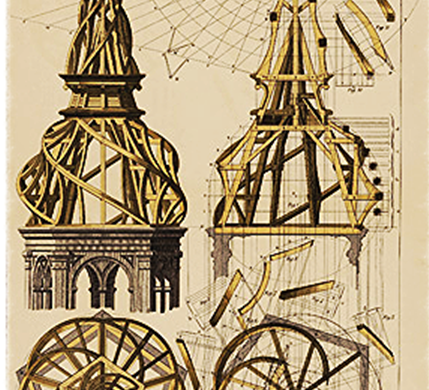
Guitarde with twisting steeple (source: http://www.monumentum.fr/maison-lucarnes-type-compagnonnique-pa45000003.html)
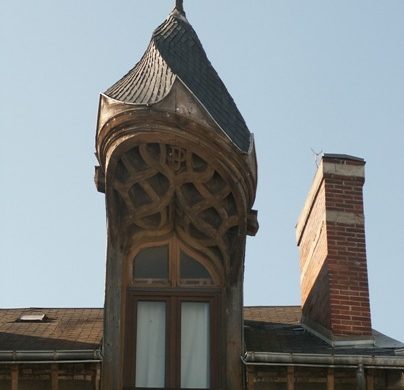
Below is a photo of Patrick Moore’s masterpiece, which is a culmination of his intensive studies in France. Note the delicate “barbs” of wood and how one piece of each St Andrew’s cross must slide through the notch in its companion piece. Incredible! (Source: https://www.historicalcarpentry.com/l-art-du-trait.html)
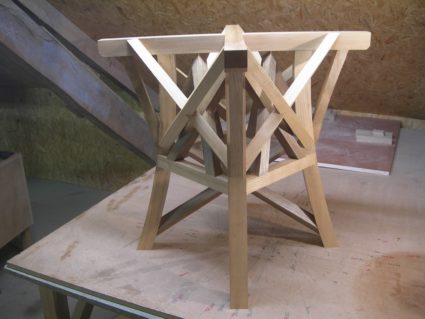
What I love about stereotomy is that it is an intuitive, intellectual muscle that can be trained and exercised over time. It allows me to visualize and see complex shapes interacting in 3D. It is also distinctly not an American way of working. Here in the US we have largely succumbed to a fracture in our trades lineage, favoring the rugged individual over traditional methodology. We favor crafty reinvention to save money or time, eagerly looking for ways to improve efficiency or repeatability. Indeed, this American trend has had its payoffs and carpentry in the US is full of examples of yankee ingenuity. There is nothing wrong with a fresh perspective if it is balanced with the wealth of knowledge passed down from the giants who came before us – and I don’t think we have this balance in the US. So studying le Trait is not only an intellectual pursuit, it is learning to speak an old language, a vocabulary which doesn’t have an American translation. It is seeking and situating myself in a different story. It is integrating my carpentry practice into a larger heritage of craft.
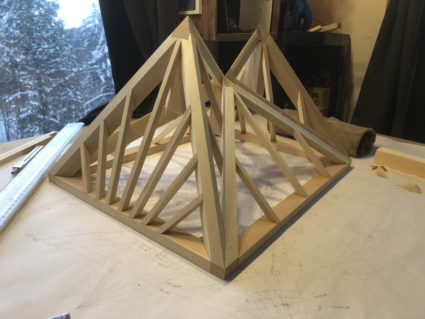 This is a model that I made several years ago as part of Patrick’s curriculum.
This is a model that I made several years ago as part of Patrick’s curriculum.
I work with Patrick remotely, studying a curriculum that he produced after studying himself in France for many years and achieving a remarkable level of scholarship in le Trait. The curriculum consists of a series of small studies, each one has a drawing and a small model to make. Occasionally there is a bigger exam at the end of a string of smaller projects. I recently completed an exam that was the largest model I’ve made so far, with a footprint of about 5’ square and standing about 5’ tall. Below are some photos and a video tour. I spent something like 100-120 hours on drawing and cutting parts for both models combined. This would take less time if I were to do it again!
Of course, with stereotomy one can create full timber-frame scale work, but it is not an efficient scale on which to practice and learn. But…I’m ready to take it to that level! If there are any prospective THVT clients out there reading this, know that I am eager to find a project with which to employ stereotomy! I think it would be particularly well suited to a pavilion or other open, outdoor structure where the timber framed roof will be showcased. You would get a small scale drawing to frame and keep if you like. Indeed, I have some assignments coming up that must be done at full scale, so I’m fishing for the right client who wants to take a dive into something different – you will come away with a piece of history, a poem in a different language, a distinct melody that is at once new and has also been sung for centuries. Please reach out if you think this might be a fit for your project- my email address is .
